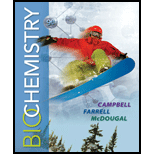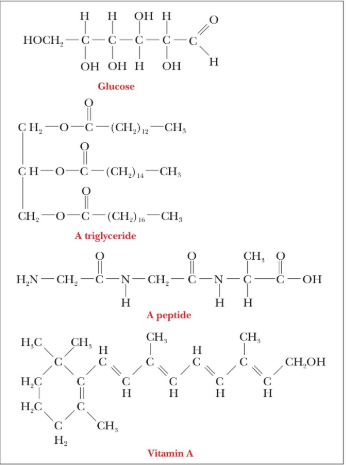
Owlv2,1 Term Printed Access Card For Campbell/farrell/mcdougal's Biochemistry, 9th
9th Edition
ISBN: 9781305962972
Author: Campbell, Mary K.; Farrell, Shawn O.; Mcdougal, Owen M.
Publisher: Cengage Learning
expand_more
expand_more
format_list_bulleted
Concept explainers
Textbook Question
Chapter 1, Problem 3RE
RECALL Identify the

Expert Solution & Answer
Trending nowThis is a popular solution!

Students have asked these similar questions
16. Which one of the
compounds below is the
final product of the reaction
sequence shown here?
OH
A
B
NaOH
Zn/Hg
aldol condensation
heat
aq. HCI
acetone
C
0
D
E
2. Which one of the following alkenes undergoes the least exothermic
hydrogenation upon treatment with H₂/Pd?
A
B
C
D
E
6. What is the IUPAC name of the following compound?
A) (Z)-3,5,6-trimethyl-3,5-heptadiene
B) (E)-2,3,5-trimethyl-1,4-heptadiene
C) (E)-5-ethyl-2,3-dimethyl-1,5-hexadiene
D) (Z)-5-ethyl-2,3-dimethyl-1,5-hexadiene
E) (Z)-2,3,5-trimethyl-1,4-heptadiene
Chapter 1 Solutions
Owlv2,1 Term Printed Access Card For Campbell/farrell/mcdougal's Biochemistry, 9th
Ch. 1 - RECALL State why the following terms are important...Ch. 1 - RECALL Match each entry in Column a with one in...Ch. 1 - RECALL Identify the functional groups in the...Ch. 1 - REFLECT AND APPLY In 1828, Wohler was the first...Ch. 1 - REFLECT AND APPLY A friend who is enthusiastic...Ch. 1 - REFLECT AND APPLY Does biochemistry differ from...Ch. 1 - REFLECT AND APPLY An earlier mission to Mars...Ch. 1 - REFLECT AND APPLY Common proteins are polymers of...Ch. 1 - REFLECT AND APPLY Nucleic acids are polymers of...Ch. 1 - REFLECT AND APPLY RNA is often characterized as...
Ch. 1 - REFLECT AND APPLY Why is the development of...Ch. 1 - REFLECT AND APPLY What are two major advantages of...Ch. 1 - REFLECT AND APPLY Why was the development of a...Ch. 1 - REFLECT AND APPLY Comment on RNAs role in...Ch. 1 - REFLECT AND APPLY Do you consider it a reasonable...Ch. 1 - RECALL List five differences between prokaryotes...Ch. 1 - RECALL Do the sites of protein synthesis differ in...Ch. 1 - REFLECT AND APPLY Assume that a scientist claims...Ch. 1 - RECALL Draw an idealized animal cell, and identify...Ch. 1 - RECALL Draw an idealized plant cell, and identify...Ch. 1 - RECALL What are the differences between the...Ch. 1 - RECALL Which organelles are surrounded by a double...Ch. 1 - RECALL Which organelles contain DNA?Ch. 1 - RECALL Which organelles are the sites of...Ch. 1 - RECALL State how the following organelles differ...Ch. 1 - RECALL List the five kingdoms into which living...Ch. 1 - RECALL Which of the five kingdoms consist of...Ch. 1 - RECALL How does the five-kingdom classification...Ch. 1 - REFLECT AND APPLY What are the advantages of being...Ch. 1 - REFLECT AND APPLY Mitochondria and chloroplasts...Ch. 1 - REFLECT AND APPLY Fossil evidence indicates that...Ch. 1 - RECALL Which processes are favored: those that...Ch. 1 - RECALL Does the thermodynamic term spontaneous...Ch. 1 - BIOCHEMICAL CONNECTIONS For the process...Ch. 1 - RECALL Which of the following are spontaneous...Ch. 1 - REFLECT AND APPLY In which of the following...Ch. 1 - REFLECT AND APPLY Why is it necessary to specify...Ch. 1 - REFLECT AND APPLY Why is the entropy of a system...Ch. 1 - REFLECT AND APPLY A reaction at 23C has G=1kJmol1....Ch. 1 - REFLECT AND APPLY Urea dissolves very readily in...Ch. 1 - REFLECT AND APPLY Would you expect the reaction...Ch. 1 - REFLECT AND APPLY The existence of organelles in...Ch. 1 - REFLECT AND APPLY Why is it advantageous for a...Ch. 1 - REFLECT AND APPLY Which would you expect to have a...Ch. 1 - REFLECT AND APPLY How would you modify your answer...Ch. 1 - REFLECT AND APPLY Would it be more or less likely...Ch. 1 - REFLECT AND APPLY What thermodynamic...Ch. 1 - REFLECT AND APPLY If cells of the kind we know...Ch. 1 - REFLECT AND APPLY The process of protein folding...Ch. 1 - REFLECT AND APPLY In biochemistry, the exergonic...
Knowledge Booster
Learn more about
Need a deep-dive on the concept behind this application? Look no further. Learn more about this topic, biochemistry and related others by exploring similar questions and additional content below.Similar questions
- Consider the reaction shown. CH2OH Ex. CH2 -OH CH2- Dihydroxyacetone phosphate glyceraldehyde 3-phosphate The standard free-energy change (AG) for this reaction is 7.53 kJ mol-¹. Calculate the free-energy change (AG) for this reaction at 298 K when [dihydroxyacetone phosphate] = 0.100 M and [glyceraldehyde 3-phosphate] = 0.00300 M. AG= kJ mol-1arrow_forwardIf the pH of gastric juice is 1.6, what is the amount of energy (AG) required for the transport of hydrogen ions from a cell (internal pH of 7.4) into the stomach lumen? Assume that the membrane potential across this membrane is -70.0 mV and the temperature is 37 °C. AG= kJ mol-1arrow_forwardConsider the fatty acid structure shown. Which of the designations are accurate for this fatty acid? 17:2 (48.11) 18:2(A9.12) cis, cis-A8, A¹¹-octadecadienoate w-6 fatty acid 18:2(A6,9)arrow_forward
- Classify the monosaccharides. H-C-OH H. H-C-OH H-C-OH CH₂OH H-C-OH H-C-OH H-C-OH CH₂OH CH₂OH CH₂OH CH₂OH D-erythrose D-ribose D-glyceraldehyde Dihydroxyacetone CH₂OH CH₂OH C=O Answer Bank CH₂OH C=0 HO C-H C=O H-C-OH H-C-OH pentose hexose tetrose H-C-OH H-C-OH H-C-OH aldose triose ketose CH₂OH CH₂OH CH₂OH D-erythrulose D-ribulose D-fructosearrow_forwardFatty acids are carboxylic acids with long hydrophobic tails. Draw the line-bond structure of cis-A9-hexadecenoate. Clearly show the cis-trans stereochemistry.arrow_forwardThe formation of acetyl-CoA from acetate is an ATP-driven reaction: Acetate + ATP + COA Acetyl CoA+AMP+ PP Calculate AG for this reaction given that the AG for the hydrolysis of acetyl CoA to acetate and CoA is -31.4 kJ mol-1 (-7.5 kcal mol-¹) and that the AG for hydrolysis of ATP to AMP and PP; is -45.6 kJ mol-1 (-10.9 kcal mol-¹). AG reaction kJ mol-1 The PP, formed in the preceding reaction is rapidly hydrolyzed in vivo because of the ubiquity of inorganic pyrophosphatase. The AG for the hydrolysis of pyrophosphate (PP.) is -19.2 KJ mol-¹ (-4.665 kcal mol-¹). Calculate the AG° for the overall reaction, including pyrophosphate hydrolysis. AGO reaction with PP, hydrolysis = What effect does the presence of pyrophosphatase have on the formation of acetyl CoA? It does not affect the overall reaction. It makes the overall reaction even more endergonic. It brings the overall reaction closer to equilibrium. It makes the overall reaction even more exergonic. kJ mol-1arrow_forward
- Consider the Haworth projections of ẞ-L-galactose and ẞ-L-glucose shown here. OH CH₂OH OH CH₂OH OH OH OH ОН OH он B-L-galactose B-L-glucose Which terms describe the relationship between these two sugars? epimers enantiomers anomers diastereomersarrow_forwardClassify each characteristic as describing anabolism or catabolism. Anabolism Answer Bank Catabolism transforms fuels into cellular energy, such as ATP or ion gradients uses NADPH as the electron carrier synthesizes macromolecules requires energy inputs, such as ATP uses NAD+ as the electron carrier breaks down macromoleculesarrow_forwardThe table lists the standard free energies (AG") of hydrolysis of some phosphorylated compounds. Compound kJ mol-1 kcal mol-1 Phosphoenolpyruvate (PEP) -61.9 -14.8 1,3-Bisphosphoglycerate (1,3-BPG) -49.4 -11.8 Creatine phosphate -43.1 -10.3 ATP (to ADP) -30.5 -7.3 Glucose 1-phosphate -20.9 -5.0 Pyrophosphate (PP) -19.3 -4.6 Glucose 6-phosphate -13.8 -3.3 Glycerol 3-phosphate -9.2 -2.2 What is the direction of each of the reactions shown when the reactants are initially present in equimolar amounts? (a) ATP + H2O ADP + P (b) ATP + glycerol glycerol 3-phosphate + ADParrow_forward
- Characterize each term or phrase as pertaining to simple or facilitated diffusion. Simple diffusion Facilitated diffusion Answer Bank requires an input of free energy lipophilic molecules directly through membrane via channels polar molecules Na+arrow_forwardSort the descriptions into properties that describe either saturated phospholipids or unsaturated phospholipids. Saturated phospholipids Saturated and unsaturated phospholipids Unsaturated phospholipids Answer Bank have no double bonds in the fatty acid carbon chains have straight fatty acid tails have at least one double bond in the fatty acid tails have bent fatty acid tails are built upon a glycerol backbone make the membrane somewhat rigid at low temperatures allow the membrane to remain fluid and flexible at low temperatures fatty acid tails pack tightly together maintain some space between adjacent phospholipidsarrow_forwardPlace the events of an action potential in order, starting and ending with a cell at its resting membrane potential. Cell starts at its resting membrane potential. Cell returns to its resting membrane potential. Answer Bank K+ channels fully open, and Na+ channels are inactivated. K* rushes out of the cell, causing repolarization. K+ channels close slowly, resulting in hyperpolarization. Na+ channel gates reset. Fast Na+ and slow K+ channels are activated. Na rushes into the cell, causing membrane depolarization. Ligand activation of the acetylcholine receptor depolarizes the membrane.arrow_forward
arrow_back_ios
SEE MORE QUESTIONS
arrow_forward_ios
Recommended textbooks for you
 BiochemistryBiochemistryISBN:9781305961135Author:Mary K. Campbell, Shawn O. Farrell, Owen M. McDougalPublisher:Cengage Learning
BiochemistryBiochemistryISBN:9781305961135Author:Mary K. Campbell, Shawn O. Farrell, Owen M. McDougalPublisher:Cengage Learning

Biochemistry
Biochemistry
ISBN:9781305961135
Author:Mary K. Campbell, Shawn O. Farrell, Owen M. McDougal
Publisher:Cengage Learning
Biomolecules - Protein - Amino acids; Author: Tutorials Point (India) Ltd.;https://www.youtube.com/watch?v=ySNVPDHJ0ek;License: Standard YouTube License, CC-BY